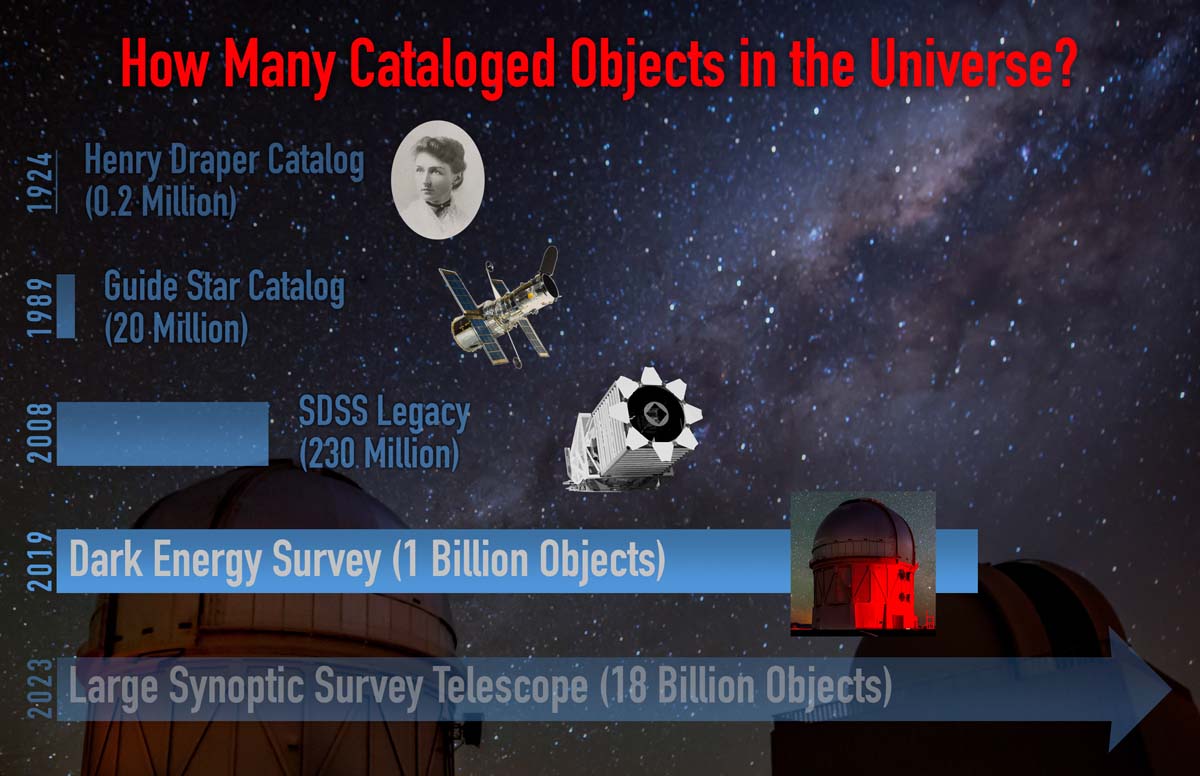NOAO: A Survey Machine and a Data Trove – Dark Energy Survey’s Rich Legacy
 Trend toward ever larger data sets in astronomy. Since the work of Annie Jump Cannon and others in creating the Henry Draper Catalog of 20,000 stars, astronomical catalogs have grown steadily in size. The Dark Energy Survey cataloged nearly 1 billion objects, more than 4 times that of the Sloan Digital Sky Survey (SDSS), the premier survey of the past decade. The Large Synoptic Survey Telescope will soon detect billions of objects, dwarfing both surveys. Credit: J. Najita, M. Newhouse & NOAO/AURA/NSF.
Trend toward ever larger data sets in astronomy. Since the work of Annie Jump Cannon and others in creating the Henry Draper Catalog of 20,000 stars, astronomical catalogs have grown steadily in size. The Dark Energy Survey cataloged nearly 1 billion objects, more than 4 times that of the Sloan Digital Sky Survey (SDSS), the premier survey of the past decade. The Large Synoptic Survey Telescope will soon detect billions of objects, dwarfing both surveys. Credit: J. Najita, M. Newhouse & NOAO/AURA/NSF.
On the night of 9 January 2019, the V. M. Blanco 4-meter telescope at the National Science Foundation’s (NSF) Cerro Tololo Inter-American Observatory (CTIO), high in the mountains of Chile, will close the camera’s shutter on the final image from the Dark Energy Survey (DES) – a survey that has mapped 5,000 square degrees of the heavens, almost one-quarter of the southern sky. Although the survey is ending, both the camera used in the survey and the survey data itself are expected to continue to yield abundant new discoveries.
Mapping the Sky to Understand Dark Energy
The Blanco telescope, which began operation in 1976, and the purpose-built Dark Energy Camera (DECam), which was mounted on the telescope in 2012, are exploring one of the most enigmatic phenomena in the Universe: dark energy. Dark energy is the mysterious force that is accelerating the expansion of the Universe.
Over the past six years, more than 400 DES scientists from over 25 institutions have collected a rich trove of data – 50 terabytes worth, mapping nearly a billion galaxies. That’s 5 followed by 13 zeros worth of bytes! Now this international collaboration is departing the telescope to study the resulting map, with the aim of probing the nature of dark energy by measuring, with high precision, the 14 billion year history of cosmic expansion.
As DES departs, CTIO continues to make full use of the instrument built to carry out the survey. DECam remains installed on the Blanco telescope, and according to Dr. Tim Abbott, a DES team member and the Blanco Telescope Scientist, “The DECam-Blanco combination is as yet unchallenged as the southern hemisphere’s most powerful tool for surveys across the optical and near-infrared spectrum. DECam is an NOAO (National Optical Astronomy Observatory) facility instrument, available to all users.”

